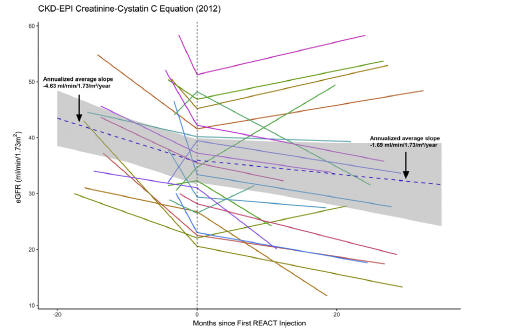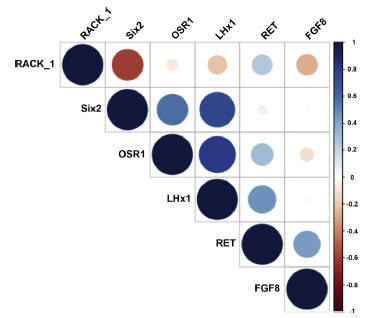
Renal Autologous Cell Therapy to Stabilize Function in Diabetes-Related Chronic Kidney Disease: Corroboration of Mechanistic Action With Cell Marker Analysis
Joseph Stavas, MD, MPH1, Guido Filler, MD, PhD2,3,4, Deepak Jain, PhD1,
John Ludlow, PhD1, Joydeep Basu, PhD1, Richard Payne, PhD1, Emily Butler, PhD1, Maria Díaz-González de Ferris, MD, PhD, MPH5 and Tim Bertram, PhD1
1ProKidney, LLC, Raleigh, North Carolina, USA; 2Departments of Paediatrics, Medicine, Pathology and Laboratory Medicine, University of Western Ontario, London, Canada; 3Schulich School of Medicine and Dentistry, University of Western Ontario, London, Canada; 4Lilibeth Caberto Kidney Clinical Research Unit, London, Ontario, Canada; and 5Department of Pediatrics, University of North Carolina at Chapel Hill, Chapel Hill, North Carolina, USA
Introduction: Chronic kidney disease (CKD) is a worldwide disease without cure. Selected renal cells (SRCs) can augment kidney function in animal models. This study correlates the phenotypical characteristics of autologous homologous SRCs (formulated product called Renal Autologous Cell Therapy [REACT]) injected into patients’ kidneys with advanced type 2 diabetes-related CKD (D-CKD) to clinical and laboratory findings.
Methods: A total of 22 adults with type 2 D-CKD underwent a kidney biopsy followed by 2 subcortical injections of SRCs, 7 ± 3 months apart. There were 2 patients who had only 1 injection. We compared annualized estimated glomerular filtration rate (eGFR) slopes pre- and post-REACT injection using the 2009 CKD-EPI formula for serum creatinine (sCr) and the 2012 CKD-EPI Creatinine-Cystatin C equation and report clinical/laboratory changes. Fluorescent Activated Cell Sorting (FACS) Analysis for renal progenitor lineages in REACT and donor vascular endothelial growth factor A (VEGF-A) analysis were performed. Longitudinal parameter changes were analyzed with longitudinal linear mixed effects model.
Results: At baseline, the mean diabetes duration was 18.4 ± 8.80 years, glycated hemoglobin (Hgb) was 7.0 ± 1.05, and eGFR was 40.3 ± 9.35 ml/min per 1.73 m2 using the 2012 CKD-EPI cystatin C and sCr formulas. The annualized eGFR slope (2012 CKD-EPI) was -4.63 ml/min per 1.73 m2 per year pre-injection and improved to -1.69 ml/min per 1.73 m2 per year post-injection (P = 0.015). There were 7 patients who had an eGFR slope of >0 ml/min per 1.73 m2 postinjection. SRCs were found to have cell markers of ureteric bud, mesenchyme cap, and podocyte sources and positive VEGF. There were 2 patients who had remote fatal adverse events determined as unrelated with the biopsies/injections or the REACT product.
Conclusion: Our cell marker analysis suggests that SRCs may enable REACT to stabilize and improve kidney function, possibly halting type 2 D-CKD progression.
Kidney Int Rep (2022) ; https://doi.org/10.1016/j.ekir.2022.04.014
; https://doi.org/10.1016/j.ekir.2022.04.014
KEYWORDS: cell-based therapy; chronic kidney disease; estimated glomerular filtration rate; selected renal cells; type 2 diabetes mellitus
© 2022 International Society of Nephrology. Published by Elsevier Inc. This is an open access article under the CC BY license (http://creativecommons.org/licenses/by/4.0/).
Approximately 37 million US adults have CKD, a major public health concern, as it is a progressive condition that culminates in end-stage kidney disease (ESKD).1,2 The economic/societal costs of CKD are
substantial.2,3 In 2018, ESKD represented 7.2% US Medicare spending.4 CKD is underreported with inconsistency in kidney disease testing.5 Large registry-based studies indicate that D-CKD is the most common cause of ESKD.6
Correspondence: Guido Filler, University of Western Ontario, 800 Commissioners Road East, E3-206, London, Ontario N6A 5W9, Canada. E-mail: guido.filler@lhsc.on.ca
Received 26 March 2022; accepted 11 April 2022
The pathomorphologic sequence of nephron loss with glomerular decapitation and progressive tubular fibrosis has been described in diabetic nephropathy.7 Once nephron loss begins, no new organoids can be formed.7 There is no cure for CKD and treatments are
| | |
Kidney International Reports (2022) | | 1 |


 ; https://doi.org/10.1016/j.ekir.2022.04.014
; https://doi.org/10.1016/j.ekir.2022.04.014


